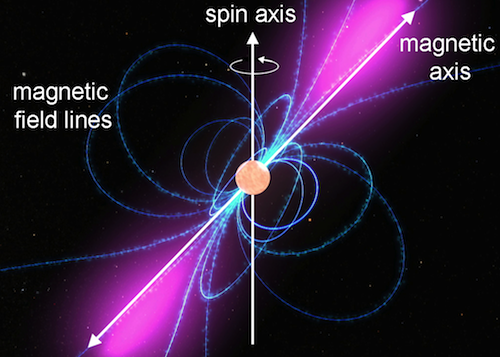Pulsar Gravitational Waves Win Nobel Prize
In 1993, the Nobel Prize for physics was awarded to Russell Hulse and Joseph Taylor of Princeton University. The prize was awarded for their discovery of the first pulsar in a binary system and subsequent work using the arrival times of pulses from the pulsar to give the first evidence of gravitational waves.
Pulsars
We can't introduce pulsars without first introducing neutron stars. A neutron star is one of the possible endpoints of stellar evolution. When a massive star dies in a supernova, the core that it leaves behind can either collapse into a black hole or into a neutron star (see links under "Other Resources" on stellar evolution for more information on how neutron stars form). Neutron stars are very dense – they have about 1.4 times the mass of our Sun smooshed into a volume with a diameter of about 20 km. Pulsars are neutron stars with strong magnetic fields, from which we observe pulses of radiation as the neutron star rotates (as illustrated below).

A diagram of a pulsar, showing its rotation axis and its magnetic axis (Image credit: NASA)
Hulse and Taylor's Discovery
Hulse and Taylor first observed the pulsar PSR 1913+16 in 1974 while they were searching for pulsars. They soon discovered that it was in a binary system with another star. In fact, PSR 1913+16 was the first pulsar to be found in a binary system. Hulse and Taylor knew that such a system would be very interesting, particularly in what it could tell us about relativity in an environment that we can't reproduce on or near the Earth.
PSR 1913+16 and its companion star orbit with a period of 7.75 hours. PSR 1913+16 rotates with a period of 59 milliseconds, as derived from the time between its pulses. Hulse and Taylor measured the arrival times of the pulses of light from PSR 1913+16 as they arrived at Earth. Using these arrival times, Hulse and Taylor could determine the orbital properties of the binary system. As the pulsar orbits its companion star, the pulsar is closer to Earth and the pulses arrive slightly sooner. When the pulsar is at periastron (the place in the orbit where the two stars are closest together), the pulses appear bunched together because the pulsar is moving fastest in its orbit at that point. By analyzing these pulses and the pulse patterns throughout the orbit of the pulsar, they were able to find the velocity of the pulsar in its orbit and subsequently calculate the orbit properties. They found the orbit is elliptical with a semi-major axis of 500,000 km.
Hulse and Taylor observed the orbit of PSR 1913+16 over time, and found the signatures of three different relativistic effects in the data. First, they found a signature of time dilation, such that when the stars neared each other in their orbit, the gravitational field is stronger, and the pulses slowed down. Second, they found evidence of the warping of spacetime, with the periastron of the orbit advancing by 4.2° each year (much faster than the advance of the perihelion of Mercury's orbit). Third, they found that the orbit itself was shrinking, based on their observation that the orbital period of PSR 1913+16 and its companion was decreasing over time. From this they determined that the size of the orbit was shrinking by 3.1 mm each orbit.
It's that shrinking orbit that was evidence for gravitational waves. In order for the orbit to shrink, energy had to be leaving the binary system. Einstein's General Theory of Relativity predicted that gravitational waves could carry energy from a system, but no one had seen evidence for gravitational waves prior to Hulse and Taylor's results. This was the first physical evidence of the existence of gravitational waves.
Note: The literature often refers to PSR 1913+16 as a "binary pulsar". Be aware that this does not necessarily mean that the two stars in the system are pulsars. Instead, it simply means that PSR 1913+16 is a pulsar that lies in a binary system. The term "binary pulsar" is not meant to reveal information about the companion star. In this case it is likely that the companion is a neutron star, but we do not detect pulses from it.
LISA and the future of gravitational waves
Even today gravitational waves have not been directly observed. Scientists have been working on the problem since this first discovery, but gravitational waves are exceedingly hard to detect. Essentially, a gravitational wave stretches and shrinks spacetime by a tiny amount. So far, there is one gravitational wave experiment that has conducted several experimental runs since 2002, but they have not yet seen the signature of gravitational waves. The next step in detecting gravitational waves is a space-based mission called LISA (Laser Interferometer Space Antenna).
Gravitational wave research is currently the very cutting-edge of astronomy and physics, and is one of the unsolved problems facing scientists today. With the projected launch of LISA in 2015, current middle- and high-school students may be the scientists and graduate students who will see the first direct evidence of gravitational waves.
Other resources
The following web pages have more detailed information:



